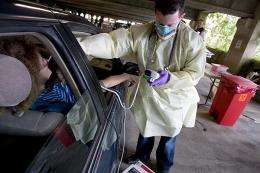Stanford Hospital does nation’s first drive-through pandemic exercise

A couple of months ago, during the swine flu scare, Stanford Hospital & Clinics had a preview of what a real pandemic might look like: Hundreds of people, fearing they might be sick with the H1N1 virus, showed up at the emergency department looking for help. Hospital officials scrambled fast, converting some space overnight into an infection-controlled triage area.
Friday morning, Stanford Hospital tested a different triage model, one that could become the standard for how hospitals respond when thousands need care at the height of a pandemic. It’s a drive-through triage-and-care system that keeps sick people in their cars, preventing them from infecting anyone else, while allowing doctors, nurses and pharmacists to care for them as quickly and efficiently as possible through an open window.
“One of the biggest issues in a pandemic is cross-contamination,” said emergency medicine physician Milana Boukhman, as she waited for another volunteer “sick” person to arrive at her treatment station, one of several set up in a parking garage near the hospital. “Cars are self-contained contamination units. And this works if you have limited resources, too.”
The system tested Friday, with 40 patients and 50 health care providers, was simple. Each pretend patient, wearing a card with a list of symptoms on a neck string, drove to each step in the process to be questioned or examined by a physician, nurse or pharmacist through the window. Evaluators and observers, both health care and emergency preparedness officials, hovered near each stage, timing transactions and recording data. Each patient was registered, evaluated, treated and then discharged.
The gathered data that will be sent on to the U.S. Centers for Disease Prevention and Control for evaluation and review.
“We know this way is more cost-efficient and safer,” said Eric Weiss, MD, medical director for both Stanford Hospital and Lucile Packard Children’s Hospital. “This doesn’t take any more staff than would be required to see patients in the emergency department.”
Weiss and Gregory Gilbert, another Stanford Hospital emergency medicine physician, share credit for the approach, which has similarities to a famous chain of hamburger sellers. In fact, not too long after Gilbert mentioned the drive-through idea to Weiss, Weiss had a personal, real-life glimpse of it. He and his family were in Montana and pulled into a McDonald’s parking lot. The restaurant, Weiss and his wife could clearly see, was packed with coughing and sick-looking people. The Weiss’s chose to their get food at the drive-through window.
Weiss’ wife, Amy, was one of Friday’s volunteer patients. She’s a former hospital emergency department administrator and an industrial engineer who saw the logic of translating hamburger delivery to health-care delivery. “You have to have something like this,” she said.
Hospital officials got on-the-spot feedback from observers that included physicians, nurses and disaster relief experts, such as American Red Cross volunteer Karl Matze. He’s seen triage and treatment in tents, but using cars as self-contained infection control units “takes things to another level.”
For Stanford and Palo Alto police officials, one of the main challenges during a pandemics is traffic control. In a dry run of preparedness plans a couple of years ago, city emergency officials used the Mitchell Park Library as a medical evaluation center, “but we concluded it was not efficient. Parking is a significant issue,” said Dennis Burns, the city’s interim police chief. Keeping people in their cars is a great idea, he said.
Margarita Casanova, a Palo Alto neighborhood emergency-preparedness coordinator, brought her one-month-old child to be a “sick” person. “I grew up in Mexico City and lived through a bad earthquake there in 1985,” she said. “It made a big impression on me. We need to be prepared.” When her part of the exercise was over, she shared her feedback with evaluators: “It took three steps to get to a doctor. You need to explain to people as they go through that they’re being prepared to see a doctor.”
Stanford Hospital’s emergency preparedness coordinator Per Schenk was at the exercise as well, observing with the recent H1N1 experience still fresh in his mind. “We almost did this a few weeks ago,” he said. “It can be done within 24 hours notice, and it’s a model that could be used almost anywhere.”
Source: Stanford University
















